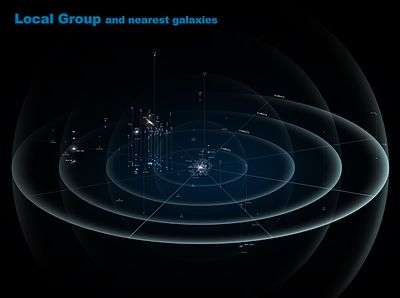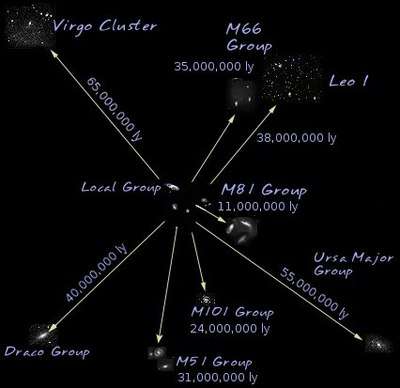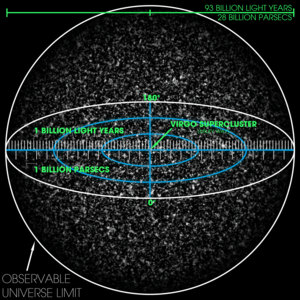Local Interstellar Cloud
The Local Interstellar Cloud (LIC), also known as the Local Fluff, is the interstellar cloud roughly 30 light-years (9.2 pc) across, through which the Solar System is moving. It is unknown if the Sun is embedded in the Local Interstellar Cloud, or in the region where the Local Interstellar Cloud is interacting with the neighboring G-Cloud.[2]
| Interstellar cloud | |
|---|---|
| low density warm hydrogen | |
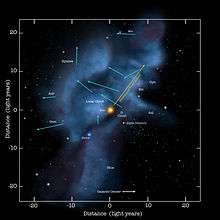 Diagram of the local clouds of matter that the Solar System is moving through, with arrows indicating cloud motion. | |
| Observation data | |
| Distance | 0[1] ly (0[1] pc) |
| Physical characteristics | |
| Dimensions | 30 ly (9.2 pc) |
| Designations | Local Cloud, LIC |
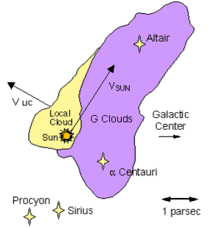
Structure
The Solar System is located within a structure called the Local Bubble, a low-density region of the galactic interstellar medium.[3] Within this region is the Local Interstellar Cloud, an area of slightly higher hydrogen density. The Sun is near the edge of the Local Interstellar Cloud. It is thought to have entered the region at some point between 44,000 and 150,000 years ago and is expected to remain within it for another 10,000 to 20,000 years.
The cloud has a temperature of about 7,000 K (6,730 °C; 12,140 °F),[4] about the same temperature as the surface of the Sun. However, its specific heat capacity is very low because it is not very dense, with 0.3 atoms per cubic centimetre (4.9/cu in). This is less dense than the average for the interstellar medium in the Milky Way (0.5/cm3 or 8.2/cu in), though six times denser than the gas in the hot, low-density Local Bubble (0.05/cm3 or 0.82/cu in) which surrounds the local cloud.[3][5] In comparison, Earth's atmosphere at the edge of space has around 1.2×1013 molecules per cubic centimeter, dropping to around 50 million (5.0×107) at 450 km (280 mi).[6]
The cloud is flowing outwards from the Scorpius–Centaurus Association, a stellar association that is a star-forming region.[7][8]
In 2019, researchers found interstellar iron in Antarctica which they relate to the Local Interstellar Cloud.[9]
Interaction with solar magnetic field
In 2009, Voyager 2 data suggested that the magnetic strength of the local interstellar medium was much stronger than expected (370 to 550 picoteslas (pT), against previous estimates of 180 to 250 pT). The fact that the Local Interstellar Cloud is strongly magnetized could explain its continued existence despite the pressures exerted upon it by the winds that blew out the Local Bubble.[10]
The Local Interstellar Cloud's potential effects on Earth are prevented by the solar wind and the Sun's magnetic field.[4] This interaction with the heliosphere is under study by the Interstellar Boundary Explorer (IBEX), a NASA satellite mapping the boundary between the Solar System and interstellar space.
See also
- Gould Belt
- List of nearest stars and brown dwarfs
- Orion Arm
- Perseus Arm
- Voyager program – probes left heliosphere in the 2010s
References
- "NAME LIC". SIMBAD. Centre de données astronomiques de Strasbourg. Retrieved March 15, 2014.
- Gilster, Paul (September 1, 2010). "Into the Interstellar Void". Centauri Dreams.
- "Our Local Galactic Neighborhood". Interstellar Probe Project. NASA. 2000. Archived from the original on 2013-11-21. Retrieved 2012-08-08.
- "Near-Earth Supernovas". NASA Science. NASA. January 6, 2003. Retrieved February 1, 2011.
- Boulanger, F.; et al. (2000). "Course 7: Dust in the Interstellar Medium". In Casoli, F.; Lequeux, J.; David, F. (eds.). Infrared Space Astronomy, Today and Tomorrow. Les Houches Physics School. Grenoble, France. August 3–28, 1998. 70. p. 251. Bibcode:2000isat.conf..251B.
- United States Committee on Extension to the Standard Atmosphere (October 1976). U.S. Standard Atmosphere, 1976. NOAA, NASA and U.S. Air Force. pp. 210–215. OCLC 3360756.
- Nemiroff, R.; Bonnell, J., eds. (February 10, 2002). "The Local Interstellar Cloud". Astronomy Picture of the Day. NASA. Retrieved December 21, 2016.
- Nemiroff, R.; Bonnell, J., eds. (February 17, 2002). "The Local Bubble and the Galactic Neighborhood". Astronomy Picture of the Day. NASA. Retrieved December 21, 2016.
- Koll, Dominik; et al. (August 2019). "Interstellar 60
Fe in Antarctica". Physical Review Letters. 123 (7). 072701. Bibcode:2019PhRvL.123g2701K. doi:10.1103/PhysRevLett.123.072701. PMID 31491090. - Opher, M.; et al. (December 24–31, 2009). "A strong, highly-tilted interstellar magnetic field near the Solar System" (PDF). Nature. 462: 1036–1038. Bibcode:2009Natur.462.1036O. doi:10.1038/nature08567. PMID 20033043.
Further reading
- "A Breeze from the Stars" at NASA Science
- "Voyager Makes an Interstellar Discovery" at NASA Science
- "Local Chimney and Superbubbles"
- Anderson, Mark (January 6, 2007). "Don't stop till you get to the Fluff". New Scientist. 193 (2585): 26–30. doi:10.1016/S0262-4079(07)60043-8.
External links


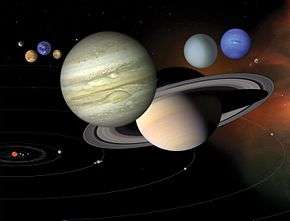
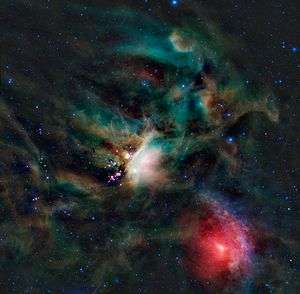
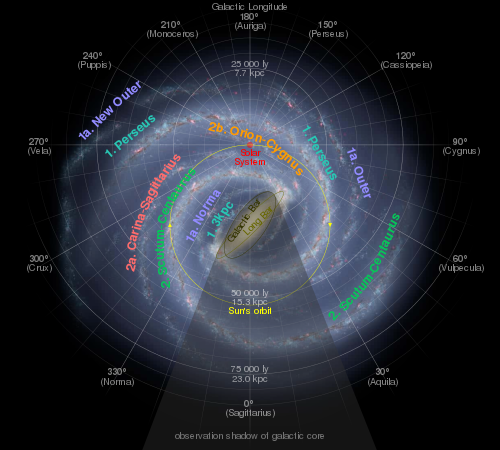
.jpg)
